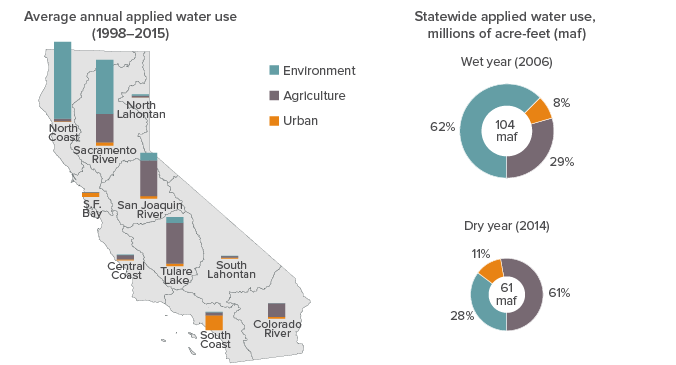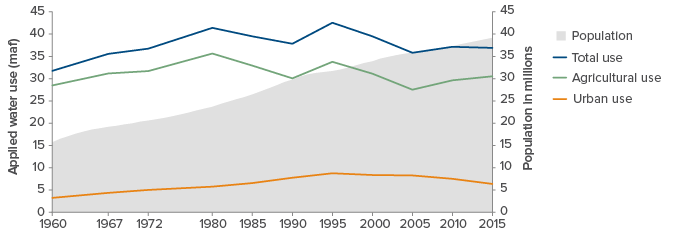How Much Water Does The Average Californian Use
- Water in California is shared across three main sectors.
Statewide, average h2o utilise is roughly 50% ecology, 40% agricultural, and 10% urban, although the percentage of water use by sector varies dramatically across regions and between wet and dry out years. Some of the water used by each of these sectors returns to rivers and groundwater basins where it can be used again. - Environmental h2o provides multiple benefits.
Ecology water apply falls into four categories: water in rivers protected as "wild and scenic" under federal and state laws, water required for maintaining habitat inside streams, water that supports wetlands within wild animals preserves, and h2o needed to maintain water quality for agronomical and urban use. One-half of California's environmental water apply occurs in rivers along the state'due south north coast. These waters are largely isolated from major agricultural and urban areas, and their wild and scenic status protects them from significant future development. In dry years, the share of h2o that goes to the surround decreases dramatically as flows diminish in rivers and streams. At the height of the 2012‒xvi drought, the state also reduced water allocations for the environs to reserve some supplies for farms and cities.

SOURCE: Department of Water Resources, California H2o Plan Update 2018 (Public Review Typhoon).
NOTES: The figure shows applied water use. The statewide average for 1998‒2015 was 77.2 maf. Surroundings (38.3 maf boilerplate) includes water for "wild and scenic" rivers, required Delta outflow, instream flows, and managed wetlands. Urban (seven.9 maf) includes residential, commercial, and industrial uses; and large landscapes. Agriculture (31 maf) includes water for crop production. Net water use—i.e., the volume consumed by people or plants, embodied in manufactured appurtenances, evaporated, or discharged to saline waters—is lower. The figure excludes h2o used to actively recharge groundwater basins (3% for urban and 1% for agronomics on average), conveyance losses (3% for urban and 8% for agriculture), and water used for free energy production (less than 2% of urban use).
- Agronomical water utilize is falling, while the economic value of farm production is growing.
More than than nine meg acres of farmland in California are irrigated, representing roughly 80% of all h2o used for businesses and homes. Higher-revenue perennial crops—basics, grapes, and other fruit—have increased as a share of irrigated acreage (from 16% in 1980 to 33% in 2015 statewide, and from 21% to 45% in the southern Central Valley). This shift, plus rising crop yields, has increased the economic render on water used for agriculture. Agricultural production generated 38% more than gross state product in 2015 than in 1980, even though farm water use was most 14% lower. Only even equally the agronomical economy is growing, the rest of the economy is growing faster. Today, farm product and food processing generate about 2% of California's gross state product, down from near 5% in the early on 1960s. - Despite population growth, total urban water employ has too fallen.
The San Francisco Bay and Due south Coast regions account for nearly urban water use in California. Both rely heavily on water imported from other parts of the country. Total urban water use has been falling even as the population grows. Even before the latest drought, per capita water utilise had declined significantly—from 231 gallons per day in 1990 to 180 gallons per day in 2010—reflecting substantial efforts to reduce water use through pricing incentives and mandatory installation of water-saving technologies similar depression-flow toilets and shower heads. In 2015, per capita use fell to 146 gallons per day in response to drought-related conservation requirements. Much of the contempo savings came from reducing landscape watering, which makes upward roughly half of all urban water employ. Per capita use has since rebounded slightly, only a new land law will require farther long-term reductions.

SOURCES: Water use: California Water Plan Updates (Department of H2o Resource, various years). Population: Section of Finance.
NOTES: Except for 2015 (a severe drought yr), the figure reports estimates for normal rainfall years. Pre-2000 estimates are adjusted to levels that would take been used in a year of normal rainfall. Estimates are for water years (October to September).
- Drought will pose major water apply challenges.
California needs to adapt to increasing drought intensity. Agriculture relies heavily on groundwater during droughts—particularly in the Primal Valley—but more than sustainable groundwater direction is needed to maintain this key drought reserve. An increase in tree and vine crops—which need to be watered every year—is making farming more vulnerable to water shortages. Country law at present requires water users to bring their groundwater basins into long-term balance by the early 2040s. This volition likely crave subcontract water use to autumn in regions that have been over-pumping, including the southern Central Valley and the Cardinal Coast. In urban areas, the greatest potential for further water savings lies in long-term reductions in landscape irrigation—a shift requiring changes in plantings and watering habits. Finally, country and federal regulators will demand new approaches to reduce impairment to fish and wildlife during increasingly intense droughts. This will require better drought planning, investments in new habitat, and setting bated water during wet years for ecosystem uses in dry years.
Sources: Department of Water Resources (water use and population for 1998–2015), State Water Resource Control Board (post-2015 urban water use), US Agency of Economic Analysis (gross state product), and National Agronomical Statistics Service (crop acreage).
Topics
Drought Freshwater Ecosystems H2o Supply Water, Land & AirHow Much Water Does The Average Californian Use,
Source: https://www.ppic.org/publication/water-use-in-california/
Posted by: morenoknestagave36.blogspot.com


0 Response to "How Much Water Does The Average Californian Use"
Post a Comment